
| KIT #: | ? |
| PRICE: | $195.00 MSRP |
| DECALS: | Three options |
| REVIEWER: | Tom Cleaver |
| NOTES: | Resin with photo etch and vacuformed parts |

| HISTORY |
The Grumman F9F Panther series was the most successful of the U.S. Navy’s first-generation carrier-based jet fighters. While outclassed in performance by the MiG-15, two Naval aviators managed to shoot down the Soviet jet on different occasions. The Panther provided escort for the piston-engine strike aircraft the fleet carriers of Task Force 77 operated in the Sea of Japan and was involved in the Korean War from the first airstrike two days after the war began to the end. More Panthers were used in Korea than any other Navy jet. The Panther was gradually replaced after 1953 by the Cougar, which was basically a swept-wing Panther.
The F9F-5 was the final version of the Panther, and the last step in the development of “first generation” Navy jets. The F9F-2 had been powered by the J-42, a license-built version of the British Nene engine, while the F9F-5was powered by the J-48, a license-built version of the Tay, which increased the speed of the F9F-5 to over 600 mph at sea level.
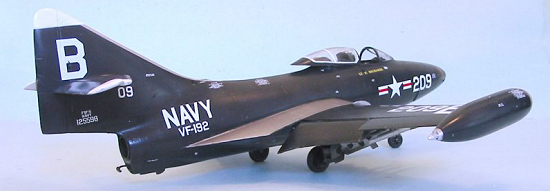 The
Panther was the first jet to be operated by the Blue Angels. I was fortunate as
a child to see the Blues in the Panther during their last season in 1955, when
they performed at NAS Buckley Field in Denver on Navy Day, which likely began my
lifelong love affair with the airplane, the Panther to this day being my
favorite jet.
The
Panther was the first jet to be operated by the Blue Angels. I was fortunate as
a child to see the Blues in the Panther during their last season in 1955, when
they performed at NAS Buckley Field in Denver on Navy Day, which likely began my
lifelong love affair with the airplane, the Panther to this day being my
favorite jet.
Probably the most well-known Panther pilot of all was a guy who only ever flew the airplane across the pages of a book and through the frames of a classic motion picture. His name was Harry Brubaker, “a lawyer from Denver.”
My love affair with the Panther was strengthened later that same year when I saw “The Bridges at Toko-ri” with my father. That movie probably had a greater impact on me than any other I ever saw growing up, because it was the movie I ever saw in which “the good guys” died. I only understood twelve years later when I saw the movie on TV after returning from my own war that this was the one of the most honest war movies ever made. Lieutenant Harry Brubaker, played by William Holden, is a reservist who is angry at the Navy for wrecking his life by recalling him to active duty when the organized reserves weren’t, who doesn’t like the job he has and is frankly afraid of the coming mission against the rail bridges in North Korea. Despite all this, he continues to fly and does his job, and when the job calls for him to make the ultimate sacrifice, he does so.
As my father - who knew what he was talking about, having survived being sunk by the Kamikazes at Okinawa - had told 10 year old me back when I was very concerned about the movie I had just seen, “doing your job in that situation is being a hero.” Twenty years later, when interviewing Thomas J. Hudner Jr., the only Navy Medal of Honor winner in the Korean War, I asked him to describe what flying off the carriers had been like. He replied, “Did you ever see ‘The Bridges at Toko-ri’?” When I said I had, he said, “It was exactly like that.”
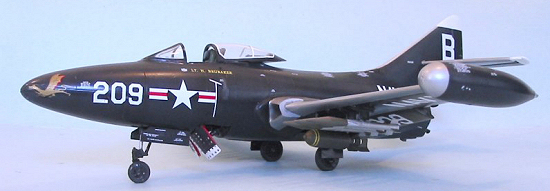 Interestingly enough, the project was highly controversial when Paramount
decided to buy James Michener’s novel and turn it into a movie. Best-selling
author (for “Tales of the South Pacific,” which had gone on to be an blow-out
success as a Broadway musical) James Michener had spent the fall of 1951 aboard
the carrier Essex when a series of mission known as “The Cherokee Strikes” were
flown against a series of North Korean targets - these became the bridges at the
fictional Toko-ri in the novel. In 1953, with McCarthyism at its height, merely
telling the story of an American who was not a hard-charging “Kill a Commie for
Christ” type created its own controversy. Paramount had originally planned to
change the end, but screenwriter Valentine Davies refused to alter Michener’s
tribute to the men he had known aboard the carriers, knowing that the story was
the real truth of war. Fortunately for posterity, Davies (who also wrote
“Miracle on 34th Street,” “The Benny Goodman Story,” “The Glenn
Miller Story,” and “Strategic Air Command” among others) had the personality and
the talent to make Paramount stick with what Michener had written. He work on
this movie at that particular dangerous time for the truth is memorialized in
the Writer’s Guild of America by the Valentine Davies Award, which recognizes
screenwriters whose body of work demonstrates a refusal to let the integrity of
a story be compromised for expediency. You will not be surprised to know that
the award has only been given out 7 times in the 45 years since Davies died of a
heart attack at 46, Hollywood being Hollywood when it comes to maintaining one’s
integrity versus maintaining one’s bank account and paying the rent.
Interestingly enough, the project was highly controversial when Paramount
decided to buy James Michener’s novel and turn it into a movie. Best-selling
author (for “Tales of the South Pacific,” which had gone on to be an blow-out
success as a Broadway musical) James Michener had spent the fall of 1951 aboard
the carrier Essex when a series of mission known as “The Cherokee Strikes” were
flown against a series of North Korean targets - these became the bridges at the
fictional Toko-ri in the novel. In 1953, with McCarthyism at its height, merely
telling the story of an American who was not a hard-charging “Kill a Commie for
Christ” type created its own controversy. Paramount had originally planned to
change the end, but screenwriter Valentine Davies refused to alter Michener’s
tribute to the men he had known aboard the carriers, knowing that the story was
the real truth of war. Fortunately for posterity, Davies (who also wrote
“Miracle on 34th Street,” “The Benny Goodman Story,” “The Glenn
Miller Story,” and “Strategic Air Command” among others) had the personality and
the talent to make Paramount stick with what Michener had written. He work on
this movie at that particular dangerous time for the truth is memorialized in
the Writer’s Guild of America by the Valentine Davies Award, which recognizes
screenwriters whose body of work demonstrates a refusal to let the integrity of
a story be compromised for expediency. You will not be surprised to know that
the award has only been given out 7 times in the 45 years since Davies died of a
heart attack at 46, Hollywood being Hollywood when it comes to maintaining one’s
integrity versus maintaining one’s bank account and paying the rent.
I
had the good fortune several years ago to meet Mickey Rooney, who memorably
played Chief NAP Mike Forney, the helicopter pilot whose job it is to rescue the
pilots regardless of the danger. Rooney was quite happy to have someone tell
him they liked that performance over all his others, because he’s quite proud of
it himself (he was nominated for an Oscar). As he told
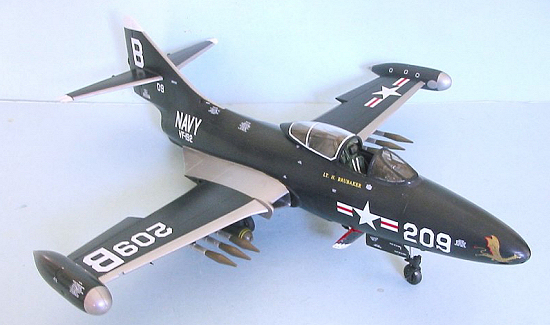 me, “When I started
campaigning for the role, Mr. Mayer called me up and told me it would ruin my
career if I was in that ‘communist claptrap.’ Well, at that point I didn’t have
a career, Mr. Mayer had dropped my contract, so I told him and everyone else I
had nothing to lose.” In fact, the role resurrected Rooney’s acting career,
which had faltered when he could no longer play youth roles.
me, “When I started
campaigning for the role, Mr. Mayer called me up and told me it would ruin my
career if I was in that ‘communist claptrap.’ Well, at that point I didn’t have
a career, Mr. Mayer had dropped my contract, so I told him and everyone else I
had nothing to lose.” In fact, the role resurrected Rooney’s acting career,
which had faltered when he could no longer play youth roles.
While in the light of history the movie has stood the test of time and generally ends up on any list of The Ten Best War Movies Ever Made, when it was first released it was a commercial dud, due to the ending. I well remember that audience walking out of the theater in dead silent shock, as I did. My screenwriting mentor, the late Wendell Mayes, once told me of the effect “The Bridges at Toko-Ri” had on his movie, “The Hunters.” The Director’s Cut of Hunters has a significant difference from what was finally released. Those of you familiar with the movie will remember the moment at the end, when May Britt has come to the hospital to visit Robert Mitchum. She leaves, turns at the door and looks back at him, where he sits on the hospital grounds. The camera pans up to the sky, then back to him. And then she turns and disappears through the door. Originally, at the moment the camera panned up from him to the sky and back, she said in voice-over: “He returned to his squadron. That summer, they caught him, high over the Yalu. As he fell in flames they followed him down, firing repeatedly - in the manner of hunters.” Director Dick Powell had told Wendell to put that in, because he wanted to make the fate of Mitchum’s character clear. However, when Jack L. Warner saw that cut, his response was “I’m not @#$%$#@!! releasing any god@#$%$#@!! movie like that @#$%#@!! bridges thing Paramount was stupid enough to do, where the @#%$%$#@! dies! The movie died with him!” And so, while the moment is still there, the words are gone. Warner may well have been right at the time, but ever since I heard that story 20 years ago, whenever I watch the movie I say the words, and it works even better.
For me, Harry Brubaker and Mike Forney and Nestor Gamidge stand in for all those guys whose names have been lost to history who helped to make us the country we are.
| THE KIT |
Paul
Fisher’s marvelous 1/32 multi-media resin Panther was first released in 2003.
The project sold out in a year and is still his most successful airplane kit
release. Fortunately, for all of you who missed it the first go-round, Paul has
made new molds from the masters, and has the second run available.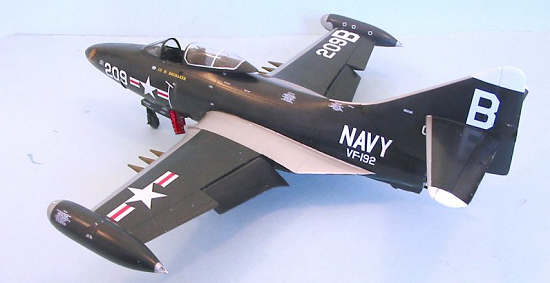
The kit is so well designed a modeler would have to make plans to screw it up in assembly (though trust me, there are still small but significant mistakes to be made). The resin is hard and smooth, with parts fit better than nearly any other resin kit I have worked on. A full suite of bombs and rockets is included. Markings are for Harry Brubaker’s “Two-Zero-Niner” of VF-192 Golden Dragons (which was a real airplane flown with the “LT. H. BRUBAKER” marking for the rest of the time the squadron flew the Panther after it starred in the movie), a Marine Panther of VMF-232 in Gull Grey and White, and the Number 5 solo plane from the Blue Angels’ 1955 team. I thought about making that airplane in memory of my childhood experience seeing it fly, but settled on the (to me) more meaningful “Two-Zero-Niner.” The decals include complete stenciling in black and white for the two operational Panthers.
| CONSTRUCTION |
Paul’s instructions are well thought out and I encourage any modeler taking up this project to commit the heretical, radical act of following them.
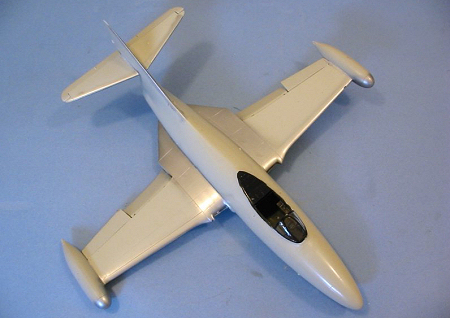 Construction starts with painting the cockpit, assembling the details, adding on
11 pennies for weight and slipping it into the fuselage. This is actually just
about as easy as I just described it, though it does require test-fitting and
sanding to get the upper cockpit walls and the nosewheel walls to fit closely -
something that takes about five minutes total with a sanding stick to
accomplish. One thing should be noted here: the wheel well and the dive brake
bay (if you are displaying the model with the dive brakes open) are both Glossy
Sea Blue overall.
Construction starts with painting the cockpit, assembling the details, adding on
11 pennies for weight and slipping it into the fuselage. This is actually just
about as easy as I just described it, though it does require test-fitting and
sanding to get the upper cockpit walls and the nosewheel walls to fit closely -
something that takes about five minutes total with a sanding stick to
accomplish. One thing should be noted here: the wheel well and the dive brake
bay (if you are displaying the model with the dive brakes open) are both Glossy
Sea Blue overall.
Once the cockpit was installed, it was time to mate the fuselage and wing. It’s a good idea to test fit here, too, since I found I needed to sand down the edges of the fuselage where they mate to the upper wing to get a good smooth fit along the lower surface joint areas. The model has some gaps fore and aft below where the wing fits to the fuselage, which were easily filled with gap-filling cyanoacrylate glue and hidden under a couple coats of Mr. Surfacer 500. I then attached the horizontal stabilizers, which also needed some gap-filling C-A applied with a toothpick, and some Mr. Surfacer to smooth the joint. I finished off major assembly by attaching the tip tanks - be careful about doing that right, test fit first, since they are “handed” to insure the correct one goes on the correct tip. Fit them first, then glue them. More CA gap-filler and Mr. Surfacer was needed for that joint also.
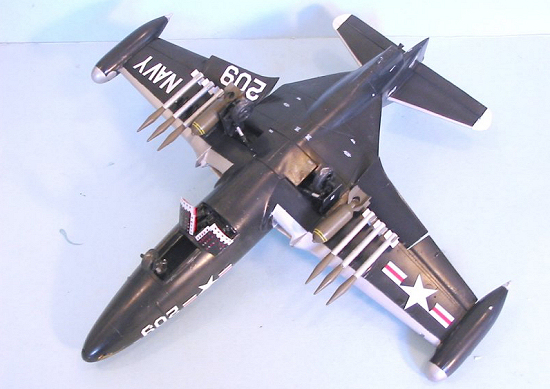 I
did not attach the control surfaces until I had sanded, smoothed and polished
the areas around the seams. Regardless of which airplane you are doing, it is
essential to get these areas you sanded as smooth as the rest of the resin
surface, because any scratch marks will be very visible under the final coat of
paint.
I
did not attach the control surfaces until I had sanded, smoothed and polished
the areas around the seams. Regardless of which airplane you are doing, it is
essential to get these areas you sanded as smooth as the rest of the resin
surface, because any scratch marks will be very visible under the final coat of
paint.
When I did attach the control surfaces, the elevators fit better in the drooped position, and the flaps will only fit in the up position if you want to fill some pretty serious gaps. Overall, the Panther kit does not have the tight parts fit of the Cougars - as Paul said to me “the Panther was the first on the learning curve.” That’s not a complaint; even with all the gap-filling I did on this kit, it fits much better than nearly any other resin kit I have ever done.
When all this was done, I fitted the wing pylons. Here I made a mistake that wasn’t recognized as such until it was too late to fix it. The kit provides both the Aero racks for rockets and the Mark 51 racks that could carry either rockets or bombs. Most F9F-5s used the Mark 51 racks. Very definitely, Two-Zero-Niner used the Mark 51 racks, as I discovered looking at the movie after attaching the Aero racks and having painted and decaled the model. Memo to self: “Do all research beforehand.” This is one of those boo-boos I can live with, since the airplane could have used the Aero racks (they were interchangeable), and 99.999999999999% of those who look at the model, even “Panther experts,” will be unlikely to spot the mistake.
| COLORS & MARKINGS |
Painting:
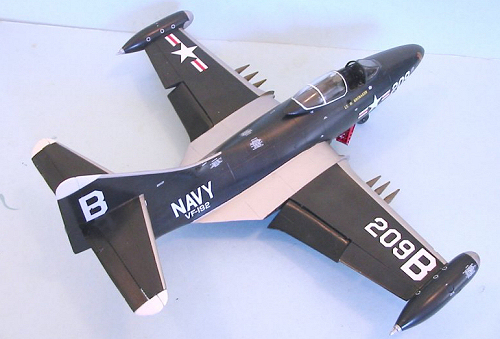 The
Panther had the leading edges of all flying surfaces and the noses of the tip
tanks painted with an aluminum lacquer that stuck to the airframe at high speeds
on those surfaces better than the Glossy Sea Blue paint did. Additionally,
VF-192 stripped the GSB paint from the upper surface of the intake/inner wing
area and painted it with the aluminum lacquer. I used some of my remaining
supply of SnJ Aluminum here, then masked over those areas with Tamiya masking
tape. I then painted the tips of the vertical fin, horizontal stabilizers and
elevators white, and masked them off.
The
Panther had the leading edges of all flying surfaces and the noses of the tip
tanks painted with an aluminum lacquer that stuck to the airframe at high speeds
on those surfaces better than the Glossy Sea Blue paint did. Additionally,
VF-192 stripped the GSB paint from the upper surface of the intake/inner wing
area and painted it with the aluminum lacquer. I used some of my remaining
supply of SnJ Aluminum here, then masked over those areas with Tamiya masking
tape. I then painted the tips of the vertical fin, horizontal stabilizers and
elevators white, and masked them off.
The model was then painted overall with Xtracrylix Glossy Sea Blue. Since the model is so big, leaving it in one monochromatic color isn’t a good idea. I put in a bit of RAF Dark Camo Grey, then went over panels. The final effect is subtle, and probably doesn’t show up in the photos here - it’s really only noticeable in person under good lighting. Glossy Sea Blue was used because it was highly resistant to salt water corrosion and sun-fading, so leaving it only with a bit of a change in hue is right. Every time I see a model done in this color with the Official IPMS Color Blotching method used, I think to myself, “there’s a modeler who didn’t know the subject matter.” If you’re going to do it at all with this color, be very subtle. In fact, I don’t do it at all with models smaller than 1/32.
I put on two coats of Future to protect the paint (since really smooth resin is a hard surface to get paint to adhere to even with primer).
At this point I attached the landing gear and wheels to keep the model from touching surfaces that might “ding” the paint.
Decals:
The
decals are printed by MicroScale and go on without problem. One “problem” I
discovered is that every set of placement instructions I have (the kit
instructions, the old Monogram kit, the Kinzey book that accompanies the F9F-5P)
gives wrong 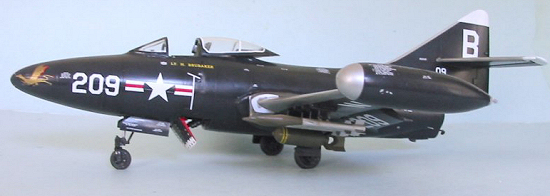 instructions for placement of the national and unit markings on the
wings. They show these much closer to the wing tip than is right. All the
photos I have of Panthers show the national insignia and unit markings with
their outer end about one half inch (not a scale one, a “real” one) in from the
tip tank, rather than the 1/4 inch or so in the markings instructions. Looking
at the movie, Two-Zero-Niner has its markings more inboard, too. Again, this
was information I discovered after everything was done, and it is not a “fatal”
problem since everyone “knows” (having looked at the instructions) that this
placement is “right.” Once again, just because the decal instructions say to do
it doesn’t mean it’s right - look at pictures before applying decals
whenever possible.
instructions for placement of the national and unit markings on the
wings. They show these much closer to the wing tip than is right. All the
photos I have of Panthers show the national insignia and unit markings with
their outer end about one half inch (not a scale one, a “real” one) in from the
tip tank, rather than the 1/4 inch or so in the markings instructions. Looking
at the movie, Two-Zero-Niner has its markings more inboard, too. Again, this
was information I discovered after everything was done, and it is not a “fatal”
problem since everyone “knows” (having looked at the instructions) that this
placement is “right.” Once again, just because the decal instructions say to do
it doesn’t mean it’s right - look at pictures before applying decals
whenever possible.
| CONSTRUCTION CONTINUES |
Once the decals were set and the model was washed to get rid of dried solvent,
I gave it two coats of Xtracrylix Satin Varnish to
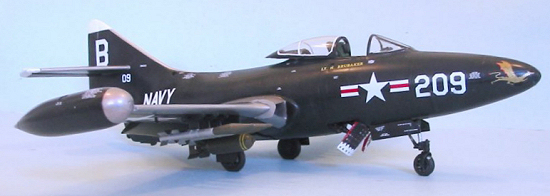 get a “used” glossy finish.
get a “used” glossy finish.
I unmasked the canopy, popped it off the model, and painted the white reinforcements. I then glued in the rear section, and attached the canopy in the open position.
The kit includes the large rocket heads for the 6.75" rockets that were also used in addition to the 5" HVARs, and I decided to cut the heads off the kit rockets and use these just because they look so different. After the rockets were assembled and painted they were attached to the pylons. I also used the 1,000-lb bombs the kit provides to finish off the ordnance.
| CONCLUSIONS |
Paul Fisher’s big Panther has to be the most impressive model of this airplane available. There are a lot of modelers who would agree with me that the Panther is one of their favorite jets. The kit is good value for the money, and even if Trumpeter did it, the price would not be that much less. Do plan to use a crane when moving it, because it is heavy.
March2006
Copyright ModelingMadness.com. All rights reserved. No reproduction in part or in whole without express permission.
Thanks to Fisher Models for the review kit. Get yours at www.fishermodels.com
If you would like your product reviewed fairly and fairly quickly, please contact the editor or see other details in the Note to Contributors.